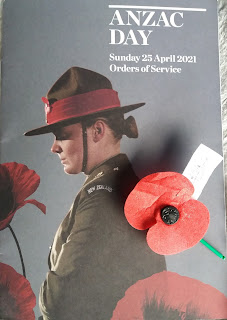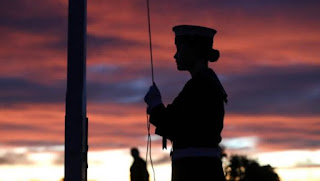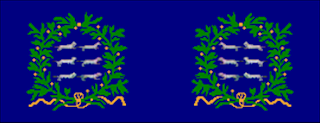25th April is an important date in New Zealand and Australia - many will already know why, but for those who may not, please see below
Anzac Day
Anzac Day is a national day of remembrance in Australia and
New Zealand that broadly commemorates all Australians and New Zealanders
"who served and died in all wars, conflicts, and peacekeeping operations"
and "the contribution and suffering of all those who have served". Observed
on 25 April each year, Anzac Day was originally devised to honour the members
of the Australian and New Zealand Army Corps (ANZAC) who served in the
Gallipoli Campaign, their first engagement in the First World War (1914–1918).
History
Anzac Day marks the anniversary of the first campaign that
led to major casualties for Australian and New Zealand forces during the First
World War. The acronym ANZAC stands for Australian and New Zealand Army Corps,
whose soldiers were known as Anzacs. Anzac Day remains one of the most
important national occasions of both Australia and New Zealand; however, the
ceremonies and their meanings have changed significantly since 1915. According
to Dr Martin Crotty, a historian at the University of Queensland, Anzac
commemorations have "suited political purposes right from 1916 when the
first Anzac Day march was held in London and Australia, which were very much
around trying to get more people to sign up to the war in 1916–1918."
Gallipoli campaign, 1915
In 1915, Australian and New Zealand soldiers formed part of
an Allied expedition that set out to capture the Gallipoli Peninsula to open
the way to the Black Sea for the Allied navies. The objective was to capture Constantinople,
the capital of the Ottoman Empire, which was an ally of Germany during the war.
The ANZAC force landed at Gallipoli on 25 April, meeting fierce resistance from
the Ottoman Army commanded by Mustafa Kemal (later known as Atatürk). What had
been planned as a bold strike to knock the Ottomans out of the war quickly
became a stalemate, and the campaign dragged on for eight months. At the end of
1915, the Allied forces were evacuated after both sides had suffered heavy
casualties and endured great hardships. The Allied deaths totalled over 56,000,
including 8,709 from Australia and 2,721 from New Zealand. News of the landing
at Gallipoli made a profound impact on Australians and New Zealanders at home
and 25 April quickly became the day on which they remembered the sacrifice of
those who had died in the war.
Though the Gallipoli campaign failed to achieve its military
objectives of capturing Constantinople and knocking the Ottoman Empire out of
the war, the actions of the Australian and New Zealand troops during the
campaign bequeathed an intangible but powerful legacy. The creation of what
became known as an "Anzac legend" became an important part of the
national identity in both countries. This has shaped the way their citizens
have viewed both their past and their understanding of the present. The heroism
of the soldiers in the failed Gallipoli campaign made their sacrifices iconic
in New Zealand memory, and is often credited with securing the psychological
independence of the nation.
Commemoration in New Zealand
The number of New Zealanders attending Anzac Day events in
New Zealand, and at Gallipoli, is increasing. For some, the day adds weight to
the idea that war is futile.
Dawn Marches and other memorials nationwide are typically
attended by the New Zealand Defence Force, the New Zealand Cadet Forces,
members of the New Zealand Police, New Zealand Fire Service, Order of St John
Ambulance Service (Youth and Adult Volunteers) as well as Scouting New Zealand,
Gir lGuiding New Zealand and other uniformed community service groups including
in most places the local Pipe Band to lead or accompany the March, and
sometimes a Brass Band to accompany the hymns.
Anzac Day now promotes a sense of unity, perhaps more
effectively than any other day on the national calendar. People whose politics,
beliefs and aspirations are widely different can nevertheless share a genuine
sorrow at the loss of so many lives in war.
Paper poppies are widely distributed by the Returned
Services Association and worn as symbols of remembrance. This tradition follows
that of the wearing of poppies on Remembrance Sunday in other Commonwealth
countries.
The day is a public holiday in New Zealand. Shops are
prohibited from opening before 1 pm as per the Anzac Day Act 1966. A prior Act
passed in 1949 prevented the holiday from being "Mondayised" (moved
to the 26th or 27th should the 25th fall on a weekend), although this drew
criticism from trade unionists and Labour Party politicians. In 2013, a
member's bill introduced by Labour MP David Clark to Mondayise Anzac Day and
Waitangi Day passed, despite opposition from the governing National Party.
Commemoration at Gallipoli
In Turkey the name "ANZAC Cove" was officially
recognised by the Turkish government on Anzac Day in 1985. In 1934, Kemal Atatürk
delivered the following words to the first Australians, New Zealanders and
British to visit the Gallipoli battlefields. This was later inscribed on a
monolith at Ari Burnu Cemetery (ANZAC Beach) which was unveiled in 1985. The
words also appear on the Kemal Atatürk Memorial, Canberra, and the Atatürk
Memorial in Wellington:
Those heroes that shed their blood
And lost their lives.
You are now lying in the soil of a friendly country.
Therefore rest in peace.
There is no difference between the Johnnies
And the Mehmets to us where they lie side by side
Here in this country of ours.
You, the mothers,
Who sent their sons from far away countries
Wipe away your tears,
Your sons are now lying in our bosom
And are in peace
After having lost their lives on this land they have
Become our sons as well.
Commemoration in other countries
Canada
In St. John's, Newfoundland, the Gallipoli offensive is
commemorated each year on 25 April by the Royal Newfoundland Regiment, which
was the only unit from North America to fight on Gallipoli, who hold a march
from Government House through the streets ending at the National War Memorial.
Members of both the Australian and New Zealand armed forces are invited each
year to participate in the march and wreath laying ceremonies.
In Ottawa, Ontario, a service starting at 9 am is held at
the Canadian War Museum.[109]
In Toronto, Ontario, Anzac service is held at the Armour
Heights Officers' Mess, Canadian Forces College.
In London, Ontario a dawn service starting at 5:45 am was
held in 2017 at the Worseley Barracks.
In Winnipeg, Manitoba Anzac Day was commemorated by the Down
Under Club of Winnipeg on Saturday 29 April 2017 from 6 pm until 10 pm at the
Scandinavian Cultural Centre.
In Calgary, Alberta, a Cenotaph Service is held annually at
Central Park with participation from the local military, held in the evening.
In Edmonton, Alberta, Anzac Day ceremonies have been held
since 2009.
In Vancouver, British Columbia, Anzac service is held at
Victory Square, Vancouver.
In Comox, British Columbia, Canada, "Vancouver Island
Anzac Day" is held on the Sunday closest to 25 April. Hosted by the HMCS
Alberni Museum and Memorial, the ceremony is held in various locations each
year on Vancouver Island
United Kingdom
In London, a 5 am Dawn Service is held, alternating between
the Australian War Memorial, and the more recently constructed New Zealand War
Memorial, both of which are at Hyde Park Corner. The day is also marked by a 9
am Wreath Laying Ceremony and service at the Gallipoli Memorial in the crypt of
St Paul's Cathedral and an 11 am Wreath Laying Ceremony and Parade at The
Cenotaph, Whitehall, both of which are attended by official representatives and
veterans associations of Australia, New Zealand, the United Kingdom and other
countries. The Wreath Laying Ceremony at the Cenotaph is directly followed by a
Service of Commemoration and Thanksgiving at Westminster Abbey. The Dawn
Service, ceremony at the Cenotaph and the Service of Commemoration and
Thanksgiving are usually attended by a member of the Royal Family representing
the Queen, and by the High Commissioners of Australia and New Zealand. Anzac
Day has been officially observed in London since 1916, when King George V and
Queen Mary attended the first commemorative service at the Abbey.
In Tetbury, Gloucestershire, England, a March is held on the
nearest Sunday to Anzac Day. A march followed by a service is held in
Leighterton Cemetery, which has several war graves of servicemen from Australia
and New Zealand. Veterans and cadets from the local ATC squadron attend.
In Oxford, Oxfordshire, England, an Anzac Day service is
organised by the Oxford University Australia New Zealand Society. In 2015 the
service was held at the University Church on 25 April, followed by dinner in
Somerville College Hall. Representatives of the Australian and New Zealand High
Commissions attend and Australian, New Zealand, and Turkish students are all
involved in the service.
A service of remembrance to commemorate Anzac Day and
Gallipoli is held at the National Memorial Arboretum in Alrewas, Staffordshire.
This commences with a service in the chapel followed by wreath laying at the
Gallipoli memorial.
United States
At the Los Angeles National Cemetery, the New Zealand and
Australian Consulates-General host the service, held at 9 am. The largest
expatriate community of New Zealanders and Australians were in Southern
California as at 2001.
In San Francisco, there is an 11 am service at the Log Cabin
in the Presidio on the Sunday nearest 25 April. Dignitaries from Australia, New
Zealand, Turkey, The United States and The United Kingdom attend. It is
followed by a BBQ picnic.
In Santa Barbara, California, Anzac Day is remembered by the
expatriate Australian and New Zealand communities. In the absence of an
official World War I remembrance, several dignitaries from many countries
including Australia, New Zealand and the US attend an 11.11 am morning service
held at the Elings Park Veteran's Memorial Walk on 25 April of each year.
In New York City, two memorials are held: the main one at
dawn, hosted by the Australian and New Zealand Consuls-General at the Vietnam
Veterans Plaza, and a commemorative service on the nearest Sunday to Anzac Day,
in the roof garden at the Rockefeller Center British Empire Building in
Rockefeller Plaza; it is an annual tradition that has been held at this locale
since 1950.
In Washington, D.C., Australian and New Zealand servicemen
and women observe Anzac Day at a dawn service at the Korean War Veterans
Memorial on 25 April and there is also a Washington National Cathedral
commemorative service.
In Honolulu the Marine Corps hosts an Anzac Day ceremony at
the National Memorial Cemetery of the Pacific, known as "The
Punchbowl".
In Fort Rucker, a dawn service is held on 25 April led by
the senior Australian liaison officer at the Fort Rucker memorial garden
adjacent to the aviation museum.
Commemoration services are also held at Bloomington
(Indiana), Boston, Chicago, Fort Lauderdale, Fort Leonard Wood, Houston, Miami,
Milwaukee, Minneapolis, San Diego and Seattle.
The Ode is from the poem For the Fallen, written by Laurence
Binyon.
Age shall not weary them, nor the years condemn.




















































